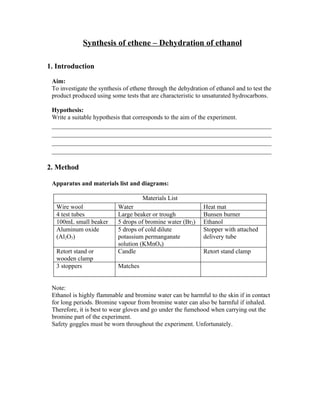
Synthesis of Ethene
- 1. Synthesis of ethene – Dehydration of ethanol 1. Introduction Aim: To investigate the synthesis of ethene through the dehydration of ethanol and to test the product produced using some tests that are characteristic to unsaturated hydrocarbons. Hypothesis: Write a suitable hypothesis that corresponds to the aim of the experiment. ____________________________________________________________ ____________________________________________________________ ____________________________________________________________ ____________________________________________________________ 2. Method Apparatus and materials list and diagrams: Materials List Wire wool Water Heat mat 4 test tubes Large beaker or trough Bunsen burner 100mL small beaker 5 drops of bromine water (Br2) Ethanol Aluminum oxide 5 drops of cold dilute Stopper with attached (Al2O3) potassium permanganate delivery tube solution (KMnO4) Retort stand or Candle Retort stand clamp wooden clamp 3 stoppers Matches Note: Ethanol is highly flammable and bromine water can be harmful to the skin if in contact for long periods. Bromine vapour from bromine water can also be harmful if inhaled. Therefore, it is best to wear gloves and go under the fumehood when carrying out the bromine part of the experiment. Safety goggles must be worn throughout the experiment. Unfortunately.
- 2. Diagrams: Figure 11: Set up of experiment. Sequential Steps: 1. Label three test tubes A, B and C. 2. Grab a fourth test tube and place a small ball of wire wool in the bottom of that test tube. Ensure that the wire wool only covers 1-2cm of the test tube and isn’t too compressed. 3. Pour a small amount of ethanol into the test tube from a beaker, just enough to cover the wire wool. 4. Slowly tip the ethanol in the test tube back into the beaker while making sure that the wire wool remains at the bottom of the test tube. 5. Fill the test tube with approximately 5cm of aluminium oxide. 6. Seal the test tube with the stopper that has the attached rubber hose and either attach the test tube to a retort stand or clamp it with a wooden clamp. 7. Fill up a trough/beaker and test tubes A,B and C with water. Invert test tube A so that it is semi-submerged in the trough and set up the experiment as shown in figure 1. 8. Heat the part of the test tube that contains the aluminium oxide until enough ethene gas is collected in test tube A. While keeping the Bunsen burner on and in place (so that no suck-back occurs), remove test tube A and quickly seal it with a stopper. Repeat this heating procedure for test tubes B and C, also sealing them with stoppers after collection of the gas. 9. Add 5 drops of bromine water (Br2(aq)) to the gas in test tube A and replace the stopper quickly after. Note down in table 1 any observations on the original and final colour of the solution. 10. In test tube B add 5 drops of potassium permanganate solution and replace the stopper quickly after. Record any observations. 11. Light a candle, turn test tube C upside down and bring the flame close to the edge of the test tube. Record any observations.
- 3. 3. Results Table 1. Qualitative Results Test Observations Tube A B C 4. Discussion Comparison of theoretical and experimental results: Compare your qualitative experimental results for each test tube to the theoretical results/information in the ‘properties of ethene’ section of your notes. Do your experimental results comply with the theoretical results? ____________________________________________________________ ____________________________________________________________ ____________________________________________________________ ____________________________________________________________ ____________________________________________________________ Questions: 1. Write the equation for the synthesis of ethene through the dehydration of ethanol with the organic compounds written in their skeleton structure form.
- 4. 2. Explain and state the reaction that occurred in test tube A. _______________________________________________________ _______________________________________________________ _______________________________________________________ _______________________________________________________ _______________________________________________________ 3. Explain and state the reaction that occurred in test tube B. _______________________________________________________ _______________________________________________________ _______________________________________________________ _______________________________________________________ _______________________________________________________ 4. Name the type of reaction that occurred in test tube C and write a balanced equation for the reaction. _______________________________________________________ _______________________________________________________ _______________________________________________________ 5. Suggest some other substances other than aluminium oxide that could be used as a catalyst for the dehydration of ethanol. _______________________________________________________ _______________________________________________________ _______________________________________________________ Conclusion Write a suitable conclusion which incorporates the aim and your hypothesis. Ensure that a comparison is made to your hypothesis. ____________________________________________________________ ____________________________________________________________ ____________________________________________________________ ____________________________________________________________
- 5. Bibliography 1) Clark, Jim 2003, Oxidation of alcohols, viewed 1/10/10, <http://www.chemguide.co.uk/organicprops/alcohols/dehydration.html> 2) The Nuffield Foundation and Royal Society of Chemistry 2010, Dehydration of Ethanol to form ethene, viewed 1/10/10, <http://www.practicalchemistry.org/experiments/dehydration-of-ethanol-to- form-ethene,237,EX.html>